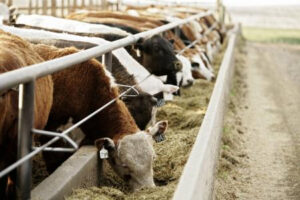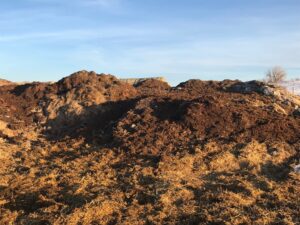Growth Promotants and the Environment
This article written by Dr. Reynold Bergen, BCRC Science Director, originally appeared in the October 2021 issue of Canadian Cattlemen magazine and is reprinted on the BCRC Blog with permission of the publisher.
Growth promotants dramatically improve the growth rates and feed efficiency of beef cattle. Trenbolone acetate (TBA) behaves like testosterone and is used in several feedlot implants (Component, Revalor, and Synovex). Melengestrol acetate (MGA) behaves like progesterone, a pregnancy hormone. Some feedlots feed MGA to suppress estrous cycles and riding activity in heifers until a few days before slaughter. Ractopamine (Actogain, Optaflexx) is a feed additive that improves weight gain, feed efficiency and leanness in the last 28-42 days before slaughter.
Growth promotants also have environmental benefits; reducing the number of days (and amount of feed) needed to finish cattle means fewer days producing greenhouse gases and manure, and less water, feed and fossil fuel inputs per pound of beef.Animals metabolize and excrete these growth promotants over time – that’s why growth promotant residues in beef are too low to pose any risk to consumers. But do these excreted residues and metabolites pose a risk to the environment? How long do they persist in soil and manure, and is there a risk they could enter surface or groundwater?
A Beef Cluster study led by Frank Larney and co-workers at Agriculture and Agri-Food Canada’s Lethbridge Research & Development Centre and the University of Saskatchewan’s Toxicology Centre is examining these questions. Their first study was published earlier this year (Ractopamine and Other Growth-Promoting Compounds in Beef Cattle Operations: Fate and Transport in Feedlot Pens and Adjacent Environments; Environmental Science & Technology. DOI: 10.1021/acs.est.0c06450).
What They Did:
This team fed two sets of cattle in 2017-18 and 2018-19. There were six experimental treatments: (1) control heifers (no growth promotants), (2) heifers implanted three times with TBA at 80-day intervals, (3) heifers continuously fed MGA, (4) control steers (no growth promotants), (5) steers implanted three times with TBA at 80-day intervals, and (6) TBA-implanted steers fed ractopamine for the last 42 days. Altogether, the experimental treatments included an implant (released and excreted at low rates over a long period), one feed additive (fed and excreted daily at low levels over a long period), and a second feed additive (fed and excreted at a high rate for a short period). Samples of fresh feces and manure were collected from the pen floor on a set schedule to monitor residue levels in feces and manure, from catch basins, and groundwater under the feedlot. Simulated rainfall experiments were also carried out to estimate how much residue would be released during a one in 100-year rainfall event in both feedlot pens and pastures that received manure. For comparison purposes, pen floor samples were also collected from two commercial feedlots that used TBA, MGA and ractopamine and two that used natural (no growth promotant) production systems. They also studied residue breakdown when manure was stockpiled or composted for 28 days (results not published yet).
What They Learned:
Not surprisingly, no growth promotant residue or metabolites were detected in the control groups or natural feedlot pens. In pens where cattle did receive growth promotants, residue levels were higher in fresh feces than in manure. The straw and soil in manure diluted the residues, and microbial activity in manure breaks these residues down faster. Residues also degraded faster in summer than in winter.
Pen floor samples: TBA residues and metabolite levels mirrored the gradual implant release; both declined over time, dissipating very quickly and were undetectable within three weeks after the final implant was given. All TBA residues and metabolites were long gone before the empty pens were restocked with the next set of cattle.
MGA residues were more stable throughout the feeding period, likely because they were administered continuously in feed at a low level. These residue levels also fell quite quickly once the feeding period ended, and residues and metabolites were gone before the pens were restocked.
Once ractopamine feeding started (later in the feeding period), its residue levels in manure were three- to four- times higher than for TBA or MGA (because ractopamine is fed at a much higher rate for a shorter time). Ractopamine residues also broke down more slowly than TBA and MGA residues. When pens weren’t cleaned after the first feeding trial, ractopamine residues were still detected in manure when the second set of cattle arrived 5 months later. However, the ractopamine residues from the first trial were undetectable by the time ractopamine feeding started late in the second trial.
Manure composting or stockpiling broke down over 95% of ractopamine residues in less than a month, approximately 3-8 times faster than when manure was left in the pens.
Rainfall experiments and catch-basin samples: After a simulated one in 100-year rainfall, TBA and MGA residues were virtually undetectable in runoff water directly from feedlot pens or from manured pastures, but ractopamine residues were detected. Catch-basin samples showed similar results.
Groundwater: No TBA, MGA or ractopamine residues were found in groundwater. The hard-packed gley layer below the manure pack presumably blocked the downward movement to groundwater.
What it Means:
TBA and MGA residues occur at low levels in feedlot feces and manure, break down very rapidlyand are unlikely to enter catch-basin or surface water or agricultural soils. Ractopamine residues are found at higher levels and last longer but can be effectively managed by composting or stockpiling manure.
Growth promotants provide significant production and environmental benefits. This study found that their residues pose minimal risks to the environment, and these can be further minimized by appropriate manure and runoff management.
The Beef Cattle Research Council is funded by the Canadian Beef Cattle Check-Off. The BCRC partners with Agriculture and Agri-Food Canada, provincial beef industry groups and governments to advance research and technology transfer supporting the Canadian beef industry’s vision to be recognized as a preferred supplier of healthy, high quality beef, cattle and genetics.
Click here to subscribe to the BCRC Blog and receive email notifications when new content is posted.
The sharing or reprinting of BCRC Blog articles is typically welcome and encouraged, however this article requires permission of the original publisher.
We welcome your questions, comments and suggestions. Contact us directly or generate public discussion by posting your thoughts below.

